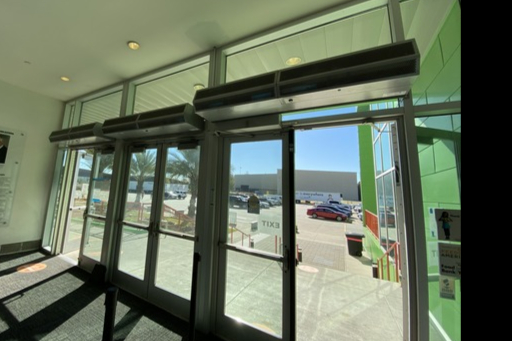History of the Air Door
Air doors, also referred to as air curtains, may seem like a marvel of the modern age: a vertical waterfall of air that separates two distinct environments from one another with great precision. This technology dates back over a century and has remained dominant to solve business ails despite decades of competing technologies.
Who came up with the air door, and how did the first units work? Below, we walk through the 100-year history of the air curtain and see how this brainchild of the post-Industrial age came to prominence.
The Birth of the Air Curtain
After several decades of sooty, smoky industrialism that shepherded America into the 20th century, something needed to change.
High-traffic throughways into and out of businesses, production floors, and packaging areas were the source of a surprising number of headaches. Business owners felt inefficiencies in several key areas:
• The increased presence of pollutants from outside
• Large temperature differentials between indoors and outdoors during the extremes of winters and summers
• Greater costs due to heat loss through doorways, pass-thru windows and other openings
Around this time came an inventor named Theophilus van Kannel. This Philadelphia-born inventor had patented the revolving door in 1888 and produced them en masse to much fanfare. However, it seems his preoccupation with doorways — particularly those that did not impede traffic while still isolating one side from the other — did not diminish.
In 1904, van Kannel received a patent for “Means for Excluding Drafts from Open Doorways,” which perfectly described an air curtain although they do so much more than just stopping drafts. The design he created differs only slightly from what manufacturers use today.
The Early Years of Air Curtain Adoption
Theophilus van Kannel owned the patent for the air door/air curtain but did not begin producing them until around a decade later. It was here that the limitations of the day seemed to catch up with him — inefficiency and high energy costs hurt the cost-effectiveness of the new invention.
Businesses were slow to catch on. By the time van Kannel died in 1919, his invention had not taken off in any meaningful way.
He received his posthumous validation when the air door began gaining popularity around the late 1940s. Initially popular in Europe, the machine made its grand U.S. entrance around 1960 when it started appearing in businesses stateside.
Among the most common applications for the air door in this era were:
• Over doorways separating cold storage areas from the rest of a building
• Warehouse entrances and exits
• Cold storage and walk-in freezers
Now a broad variety of industries realize a wide range of benefits using an air door, many of them unexpected and almost revolutionary.
Similar to its growth in post-WWII Europe, the air door’s appeal extended both to warehousing and production needs as well as storefronts. People noticed how appealing it was to see a business with its doors wide open, even in the dead of winter or summer and how it increased staff productivity, increased sales and protected the interior from drafts, debris, flying insects and can stop wind.
Air Door Technology: Enormous Advancements and Innovation
Today’s air curtain may take its inspiration from van Kannel’s 1904 patent. In terms of efficiency and reliability, it has become a far more elegant piece of technology.
Our air curtains have several compelling advantages:
• They are virtually maintenance-free
• They perform their barrier function without hampering passage or creating obstructions that can lead to accidents
• They function well in both winter and summer conditions offering unique benefits to the different seasons and their climatic challenges
• Air curtains block pollutants from entering workspaces, restaurants, walk-in freezers, transportation hubs, educational settings, manufacturing centers, high-tech manufacturing facilities, healthcare settings – every commercial setting has a challenge or impediment that an air door solves
Learm more about how an air doors/air curtains could be the high-tech, no-footprint solution to lowering your business’s energy bills and improving efficiency while providing you with a sustainable, green facility.




